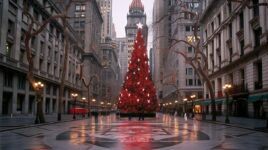
How Is Christmas Celebrated in Argentina
Christmas in Argentina is a time of joy, celebration, and rich traditions that hold great significance in Argentine culture. The holiday season is marked by a variety of unique customs, preparations, and observances that make it distinct from Christmas celebrations in other countries.
From festive decorations to traditional music and dance, as well as the importance of family gatherings and religious observances, Christmas in Argentina is a cherished time of year for many. In this article, we will explore the various aspects of how Christmas is celebrated in Argentina, including its traditions, preparations, food, family and community gatherings, religious observances, gift-giving customs, and New Year’s Eve celebrations.
As we delve into the traditions and customs specific to Argentina during Christmas, it’s important to understand the cultural significance of the holiday in Argentine society. The unique blend of European and Latin American influences has shaped the way Christmas is celebrated in Argentina, giving rise to a rich tapestry of rituals and practices that are deeply rooted in the country’s history and heritage.
Preparations for Christmas in Argentina involve a range of activities, from decorating homes and public spaces to preparing traditional dishes that hold special meaning during the holiday season. Colorful decorations and symbols associated with Christmas adorn the streets, creating a festive atmosphere that adds to the joyous spirit of the occasion.
Music also plays an integral role in Christmas celebrations in Argentina. Traditional songs and dances have been passed down through generations, adding an extra layer of merriment to the holiday festivities. Additionally – family gatherings are central to Christmas celebrations in Argentina. Loved ones come together to share meals, exchange gifts, participate in community events – ensure that cherished traditions are upheld during this special time of year.
Religious observances also play a significant role in how Christmas is celebrated in Argentina. Church ceremonies and religious traditions are deeply ingrained within the fabric of Argentine society – adding spiritual depth to the holiday season.
Gift-giving has its own set of unique customs during Christmas in Argentina – reflecting an emphasis on thoughtfulness and generosity among loved ones. Moreover – markets and festivals become vibrant hubs during the holiday season – offering unique attractions while bringing communities together for joyful celebrations leading up to New Year’s Eve when another round of festivities takes place.
Traditions and Customs
Christmas in Argentina is a joyous and festive time, celebrated with unique traditions and customs that are specific to the country. One of the most distinct features of Christmas in Argentina is the observance of “Nochebuena,” or Christmas Eve, which holds great significance in Argentine culture. Families come together for a special dinner on Christmas Eve, where they enjoy traditional dishes and exchange gifts.
A common tradition during Nochebuena is for families to attend midnight mass at local churches, followed by fireworks and celebrations that last well into the early hours of Christmas Day. This blend of religious observance and lively festivities is a hallmark of how Christmas is celebrated in Argentina.
Another important tradition in Argentina is the display of nativity scenes or “pesebres” in homes, as well as public spaces such as plazas and community centers. These nativity scenes feature handcrafted figurines representing the Holy Family, shepherds, and other characters from the Nativity story.
In addition to these traditions, many Argentinians also participate in “La Rúa,” a lively reenactment of biblical events leading up to the birth of Jesus. This tradition involves parades, music, and colorful costumes, adding an extra element of fun and excitement to the holiday season.
When compared to other countries’ Christmas traditions, Argentina stands out for its unique blend of Catholic influence and indigenous customs. This fusion has resulted in a rich tapestry of holiday rituals that are distinctively Argentine.
Overall, Christmas in Argentina is a time for family gatherings, community celebrations, and cherished customs that have been passed down through generations. The focus on faith, togetherness, and joy makes this holiday season a truly special time for all who celebrate it.
| Christmas Traditions | Argentina |
|---|---|
| Nochebuena | Significant celebration on Christmas Eve with special dinner and gift exchange |
| Nativity Scenes | Display of handcrafted nativity scenes in homes and public spaces |
| La Rúa | Lively reenactment involving parades, music, and colorful costumes |
Preparation and Decorations
In Argentina, the preparation for Christmas begins weeks in advance, as families and communities come together to decorate their homes and public spaces. One of the most important traditions is setting up the nativity scene, known as “pesebre,” which includes not only the usual figures of Mary, Joseph, and the baby Jesus, but also other characters such as gauchos (Argentine cowboys) and regional animals.
Another important aspect of Christmas preparations in Argentina is the decoration of Christmas trees. While many households opt for artificial trees due to the hot summer weather during the holiday season, some still prefer real pine trees for a more authentic feel. In addition to traditional ornaments like lights, garlands, and tinsel, many Argentine families add unique decorations that reflect their cultural heritage, such as handcrafted ornaments or items representing the country’s local wildlife and flora.
Popular Decorations and Symbols
One of the most significant symbols of Christmas in Argentina is the poinsettia flower. Known locally as “flor de nochebuena,” this bright red plant is used extensively in floral arrangements and home decorations during the holiday season. In addition to poinsettias, other popular decorations include colorful paper lanterns called “globos” and symbolic elements related to nativity scenes.
Argentinians also commonly adorn their homes with festive lights and ribbons, creating a joyful atmosphere that adds to the spirit of Christmas. Moreover, it’s not uncommon for businesses and public areas to be adorned with large decorative displays that showcase traditional motifs and symbols associated with Christmas in Argentina.
How Argentinians Prepare for Christmas
The weeks leading up to Christmas are filled with various activities aimed at preparing for the holiday. Families often engage in thorough cleaning and organizing of their homes in a tradition known as “la limpieza de fin de año” (end-of-year cleaning). This practice symbolizes leaving behind any negative energy from the past year and making way for new blessings in the upcoming one.
Furthermore, Argentinians also participate in food-related preparations by stocking up on essential ingredients for their favorite Christmas dishes. Shopping for gifts for loved ones is another significant part of getting ready for Christmas in Argentina. Whether it’s purchasing presents from stores or crafting handmade items, gift-giving plays a central role in Argentine holiday customs.
Music and Dance
In Argentina, music and dance play a significant role in Christmas celebrations. The traditional Christmas songs and dances are an integral part of the festive atmosphere, adding to the joy and excitement of the holiday season. The music and dance customs in Argentina during Christmas are distinctly unique, setting them apart from other countries’ traditions.
One of the most popular traditional Christmas dances in Argentina is the “zamba.” This graceful and elegant dance is performed with elaborate costumes and choreography, often telling a story or depicting scenes from the Nativity. The zamba is typically accompanied by live music, including string instruments like guitars and charangos, as well as traditional wind instruments such as flutes. The beautiful melodies and rhythms of the zamba fill the air during Christmas gatherings and festivities.
In addition to the zamba, Argentine Christmas celebrations also feature lively folk music known as “villancicos.” These are festive songs with catchy tunes and cheerful lyrics that capture the spirit of Christmas. Villancicos are sung by people of all ages, bringing communities together in song and celebration.
The role of music in Christmas celebrations goes beyond just entertainment; it serves as a unifying force that brings people closer together during this special time of year. Whether it’s through traditional dances like the zamba or joyful songs like villancicos, music creates a sense of shared cultural identity and belonging among Argentinians during Christmas.
As part of their preparations for Christmas, many families in Argentina also engage in musical activities such as caroling in their neighborhoods or participating in community concerts featuring traditional holiday music. These musical traditions not only enhance the festive ambiance but also foster a sense of camaraderie and togetherness within local communities.
Moreover, many churches organize special musical performances and choir recitals to commemorate the birth of Jesus Christ. These religious musical events add a spiritual dimension to the holiday celebrations while showcasing Argentina’s rich musical heritage.
Food and Feast
In Argentina, Christmas is a time for gathering with loved ones and indulging in traditional festive dishes. The holiday season is an important part of Argentine culture, and the culinary traditions associated with Christmas are a significant aspect of the celebrations.
One of the most iconic dishes served during Christmas in Argentina is lechón, which is a roasted suckling pig. This dish is often the centerpiece of the Christmas feast and is enjoyed by families across the country. Other popular savory dishes include tamales, empanadas, and asado (Argentinian barbecue). These hearty and flavorful meals are often accompanied by a variety of salads and side dishes.
For dessert, it is customary to enjoy pan dulce, which is similar to Italian panettone. This sweet bread is filled with candied fruits and nuts, and it is often paired with a glass of sidra (sparkling cider) or champagne. Another favorite dessert during Christmas in Argentina is turron, a type of nougat made with almonds or other nuts.
In addition to these traditional dishes, many families also prepare special recipes that have been passed down through generations. These recipes often hold sentimental value and are cherished as a way to connect with family heritage during the holiday season.
The culinary traditions surrounding Christmas in Argentina play an integral role in bringing families together. The act of preparing and sharing these festive meals fosters a sense of togetherness and unity among loved ones. Whether it’s through cooking together in the kitchen or sitting down to savor the flavors of these time-honored dishes, food holds a special place in Argentine Christmas celebrations.
Overall, the feast that accompanies Christmas in Argentina reflects the rich cultural heritage of the country and serves as a reminder of the importance of tradition and family during this festive time of year.
Family and Community
In Argentina, Christmas is not only a time for celebrating with family, but also a time for community gatherings and events. The holiday season is an important time for people to come together, share traditions, and create lasting memories with their loved ones.
Importance of Family Gatherings
Family gatherings are at the heart of Christmas celebrations in Argentina. It is common for extended family members to come together for a festive dinner on Christmas Eve, known as “Nochebuena.” This dinner often includes traditional dishes such as roasted meats, salads, and sweets. Families exchange gifts and enjoy each other’s company late into the night.
Community Events and Celebrations
In addition to family gatherings, many communities in Argentina hold public events and celebrations during the holiday season. These can include outdoor markets, live music performances, and festive parades. One popular tradition in Argentina is the reenactment of the Nativity scene, called “pesebre viviente,” which takes place in various towns and cities across the country.
How People Spend Time Together
During Christmas in Argentina, people spend time with their loved ones by participating in various activities such as attending neighborhood events, going to church services together, or simply enjoying leisurely walks through beautifully decorated streets. Many families also join in communal activities such as volunteering at local charities or taking part in charity events to help those in need during the holiday season.
The sense of community during Christmas extends beyond personal relationships to include a spirit of generosity and compassion towards others. Sharing meals with neighbors, helping those less fortunate, and spreading joy through acts of kindness are all integral parts of how Argentinians celebrate Christmas as a community.
Religious Observances
While family and community play a significant role in Christmas celebrations in Argentina, religious observances are also central to the holiday. Many people attend Midnight Mass on Christmas Eve as a way to honor the religious significance of the holiday.
Churches throughout the country hold special services that are attended by both devout believers and those who simply wish to participate in the spiritual aspects of the holiday. Religious imagery and symbols related to the birth of Jesus Christ are prominent decorations seen during this time.
Religious Observances
In Argentina, Christmas is not only a time for festive celebrations and merry-making, but also a deeply religious observance. The religious aspect of Christmas holds great significance in Argentine culture, as the majority of the population identifies as Roman Catholic. The holiday is a time when churches are adorned with elaborate decorations, and religious ceremonies take place to commemorate the birth of Jesus Christ.
One of the most anticipated religious observances during Christmas in Argentina is the midnight mass, known as “Misa de Gallo” or Rooster’s Mass. This tradition dates back to the early colonial period when roosters were believed to have announced the birth of Jesus.
Families and friends gather at churches across the country to attend this special mass, which usually features hymns, prayers, and a retelling of the Nativity story. The atmosphere is filled with reverence and joy as worshippers come together to celebrate the spiritual essence of Christmas.
Another significant religious observance in Argentina during Christmas is the “Novena Navideña,” a nine-day series of prayers leading up to December 25th. Families often come together to recite these prayers each evening, reflecting on various aspects of the Nativity story and expressing gratitude for blessings received throughout the year. The Novena Navideña serves as a time for spiritual reflection and unity within households, reinforcing the value of faith and devotion during the holiday season.
Beyond these traditional practices, many communities in Argentina also organize outdoor nativity scenes or “pesebres,” which depict the birth of Jesus in intricate detail. These displays are often accompanied by live performances featuring actors portraying characters from the Nativity story, further enhancing the immersive experience for visitors.
Overall, religious observances play a central role in shaping Christmas celebrations in Argentina, providing a space for individuals and families to deepen their faith, express gratitude, and seek unity within their communities.
- Midnight mass (“Misa de Gallo”)
- Novena Navideña
- Outdoor nativity scenes (“pesebres”)
Gift Giving
One of the most anticipated aspects of Christmas in Argentina is the tradition of gift-giving. Similar to other countries, Argentinians exchange gifts with their loved ones as a way to show appreciation and love during the holiday season. The excitement and joy of receiving and giving gifts is an integral part of the Christmas celebrations in Argentina.
In Argentina, gift-giving takes place on Christmas Eve, unlike some other countries where gifts are exchanged on Christmas Day. Families come together for a festive dinner and afterwards, they exchange presents. Children eagerly wait for midnight when they can open their presents. It is also common for adults to participate in a Secret Santa or “amigo invisible” gift exchange where names are drawn at random and each person buys a gift for the person they’ve picked.
The types of gifts exchanged in Argentina during Christmas vary, but popular choices include toys for children, clothing, accessories, and small electronic gadgets for adults. Many families also give traditional food items like panettone (a sweet bread) or other festive treats. Some people also choose to give handmade gifts or personalized items to add an extra sentimental touch to the presents.
Overall, gift-giving during Christmas in Argentina is seen as an opportunity to express gratitude and love towards family and friends. The act of giving and receiving gifts strengthens relationships and brings joy to both the giver and the recipient, making it a cherished part of the holiday season in Argentina.
Christmas Markets and Festivals
Argentina is known for its vibrant and festive Christmas markets and festivals that take place throughout the country during the holiday season. These events play a significant role in the Christmas celebrations, offering a unique and lively experience for both locals and tourists alike.
One of the most popular Christmas markets in Argentina is the Feria de Mataderos in Buenos Aires. This market features traditional crafts, artisanal products, and delicious food, giving visitors a taste of Argentine culture and traditions during the holiday season. Another well-known Christmas market is the Feria de Navidad de Buenos Aires, which takes place in Plaza Francia and offers a wide variety of gifts, decorations, and local treats.
In addition to traditional Christmas markets, Argentina also hosts numerous festive events and festivals during this time of year. One notable festival is the Fiesta Nacional del Solsticio, celebrated in various cities across the country. This festival showcases traditional music, dance performances, art exhibitions, and culinary delights, all infused with the spirit of Christmas.
These Christmas markets and festivals are not only places for shopping and entertainment but also serve as opportunities for community gatherings and socializing. Families come together to enjoy the festive atmosphere while savoring traditional holiday treats such as panettone, turrón, and hot chocolate.
Furthermore, these events often feature live music performances with traditional carols played by local musicians. The sounds of cheerful tunes fill the air as people come together to celebrate the joyous occasion.
Overall, Christmas markets and festivals play a vital role in celebrating the holiday season in Argentina. They provide an opportunity for people to come together, share in the festive spirit, and partake in beloved traditions that are cherished by many. Whether it’s enjoying local delicacies or finding unique gifts for loved ones, these events capture the essence of Christmas in Argentina.
New Year’s Eve
In conclusion, Christmas in Argentina is a time of great joy, celebration, and tradition. While it may share some similarities with other countries’ Christmas celebrations, Argentina has its own unique customs and traditions that make the holiday season truly special. From the elaborate preparations and decorations to the delicious food and festive music and dance, Christmas in Argentina truly encompasses the spirit of the season.
As the holiday season draws to a close, Argentinians eagerly anticipate New Year’s Eve, another important celebration filled with its own set of traditions. Just like Christmas, New Year’s Eve is a time for family gatherings and community events. It is a time to reflect on the past year and look forward to new beginnings in the coming year.
In Argentina, New Year’s Eve is celebrated with fireworks, music, dancing, and feasting. People gather with their loved ones to countdown to midnight and welcome the new year with hope and optimism. Similar to Christmas gift-giving traditions, exchanging gifts on New Year’s Eve is also common as a way to show love and appreciation for family and friends.
While Christmas may be more focused on religious observances, New Year’s Eve leans more towards parties and social gatherings. However, both holidays emphasize the importance of spending time with loved ones and creating lasting memories together.
Overall, Christmas in Argentina is a time where traditions are honored and cherished – from honoring religious observances to celebrating with loved ones – while New Year’s Eve marks an exciting transition into a new year full of hope and promise. The holiday season in Argentina holds a special place in the hearts of its people as they come together to celebrate both old traditions and new beginnings.
So when asking “how is Christmas celebrated in Argentina”, one must also remember that this joyous season extends into welcoming the new year as well.



